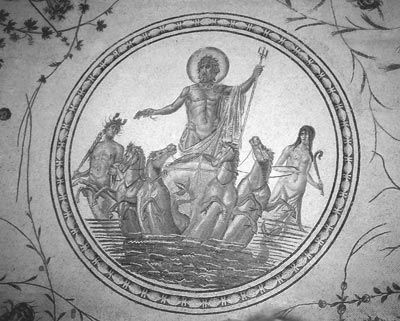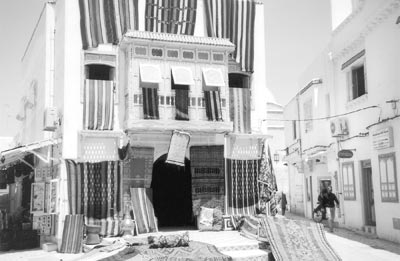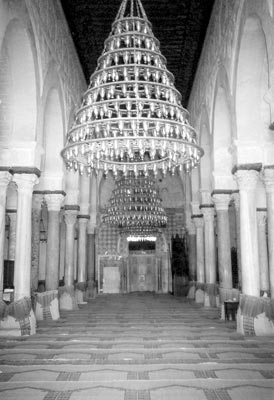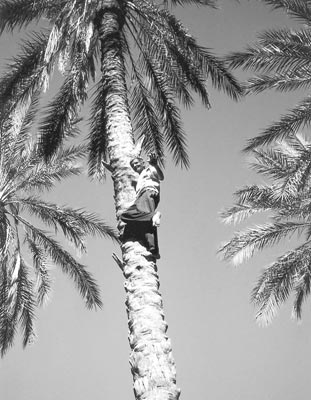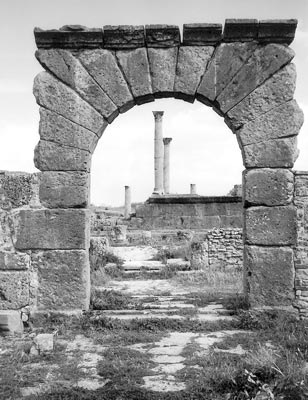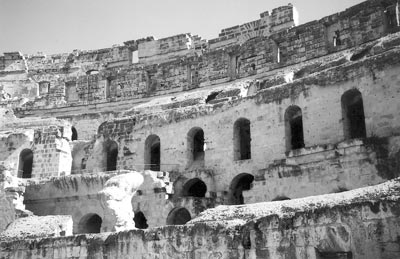Roman ruins to the sands of the Sahara — an encompassing tour of Tunisia
by Judith Anshin, Contributing Editor
Many years ago I spent quite a bit of time at either end of North Africa — in Morocco and Egypt — but the countries in between had always eluded me. Finally, in May ’07, I visited Tunisia, with Vantage Deluxe World Travel (Boston, MA; 800/322-6677). While the company’s phone system was diabolical and their customer service needed a lot of improvement, the tour itself went very smoothly and was memorable for the sights and experiences.
First impressions
Tunis, the capital, is a sprawling, low-rise city along the Mediterranean Sea. The international airport is quite nice, with an exceptionally beautiful ceiling in the central arrival hall. The Immigration officers were efficient and friendly, and soon I was on my way to a deluxe hotel in one of the many suburbs of Tunis.
On the drive from the airport I was immediately struck by how clean everything was. I had been in Nepal only three weeks before, so the difference was remarkable to me. Throughout the country I saw little of the trash and litter along the roads that is often found in less-developed countries.
Another enduring impression of Tunisia is how friendly everyone was toward Americans. Although Islam is the predominant religion of the country, the first president of the Republic of Tunisia following the country’s independence from France, Habib Bourguiba, established a secular government, abolishing the Quranic law courts and banning polygamy, divorce by renunciation and the wearing of veils in schools.
Only in the more remote southern area of the country, near the Sahara Desert, did I see perhaps a total of one to two dozen women wearing any kind of veil or body covering. In the rest of the country, the women wore typical Western-style clothing and no head coverings of any kind.
Women have achieved much in Tunisia. They make up 22.7% of the members of the Chamber of Deputies, and seven women are members of the government leadership.
Personal experiences
Vantage Travel schedules what they call “cultural connections” and we had several during the tour. One evening in Tunis a married couple, both professors at the local university, talked with us about life in Tunisia. The wife had studied in the U.S. and teaches modern American literature, while her husband teaches English literature. Both seemed very frank in their answers to our many questions, even about topics such as abortion, crime, the role of women in Tunisian society, the economy and the school system.
Toward the end of the tour, we had an early-evening tea with two young women in Sousse, and they were equally open and frank in answering our many questions. Because we had little extended contact with locals otherwise, these cultural connections were very important to me and I commend Vantage for having them.
Another evening, we broke into small groups, each group having dinner in a private home. My host was a gentleman who had worked for Saudi Arabian Airlines for 25 years as a maintenance person. After 9/11 and the subsequent wars in Afghanistan and Iraq, when Saudi Arabia expelled most foreigners from the country, he was expelled and lost his job.
The evening spent with him and his family, apart from the wonderful dinner, provided a glimpse into the life of a local family and the far-reaching effects of the war on terror. All of us in my group were surprised to learn that Muslims from other countries were expelled from Saudi Arabia.
Other tour members remarked to me that they felt the conversations with the various hosts in the homes they visited gave them a broader picture of life in Tunisia than what we were seeing and hearing from our guide.
Touring Tunis
Our first day in Tunis was a Sunday, allowing us to explore the city without traffic — a pleasure. The French influence was obvious in the wide boulevards and in much of the architecture in the main part of this quite attractive city. I would have enjoyed a few more days there to just wander on my own.
The Bardo Museum was something I had looked forward to visiting for a very long time, and it did not disappoint in any way. It is the second- largest museum in Africa, after the Cairo Museum, and is housed in what was built to be a king’s palace. The king died a year after it was completed, and his successor moved into a place nearby, now the home of the Tunisian Parliament.
The museum, at 11,000 square meters in size and with 5,200 square meters of exhibit space, displays 6,000 works of art and 2,200 square meters of mosaics. Another 15,000 pieces of art are in storage awaiting an expansion of the museum.
The mosaics comprise the most beautiful and extensive collection I have ever seen. In Room 10 is a huge mosaic measuring 140 square meters that came from the villa of a wealthy horse breeder in the city of Sousse.
Each room and floor in the museum is well laid out and contains remarkable pieces. As at all great museums in the world, one needs days to see each room properly, but I was satisfied that I had seen the most important pieces.
The nearby ruins of the ancient city of Carthage, located on the coast, are widely dispersed and difficult to see in a short time frame. The Tophet, or burial area, was the site of the discovery of more than 20,000 urns, each containing ashes of a child thought to have been sacrificed there (although there is some disagreement between contemporary historians on the veracity of this belief) and each marked by a stele. Viewing the stele, only a small number of which are on display, was sobering.
The Antonine Baths, once the largest in the Roman Empire, could hold 25,000 people at one time. Only the lowest level of the baths remains today, located in a nice waterfront setting.
A surprise addition to the tour that first day turned out to be one of the more memorable events of the entire tour: the American Military Cemetery. Dedicated on July 14, 1960, its 27 acres contain the graves of 2,841 military men and women, the majority of whom perished during the North African Campaign, plus a wall of remembrance engraved with the names of 3,724 missing military personnel.
Families could choose to have their loved ones buried there or returned home. Four sets of brothers are buried there next to each other, even though not all perished in the North African Campaign.
Men in our tour group who served in World War II participated in the laying of a wreath — an emotional moment for all of us.
Dougga
After a very long first day of touring, the 2-hour drive to Dougga the next day was a welcome respite. One of 200 Roman cities in Tunisia, it is the best preserved in all of North Africa.
Thankfully, the weather was a bit overcast and cool, because on a clear, hot day it would quickly get uncomfortable exploring the site in depth, as we did.
There was an unusual number of temples here, the Capitol Temple being the most famous. Said to be the finest example of the building technique known as opus africanum, it still dominates the site, but the remaining temples as well as the theater, baths, agora and homes are equally interesting and photogenic. The theater, which could seat 3,500, was roofed with wood; today it is home to the Dougga Summer Festival.
On the way back to Tunis we stopped at Thuburbo Majus, another Roman city. Here, also, the Capitol dominates the ruins. At the Bardo Museum we saw pieces from a giant statute of Jupiter that once stood as a protector here. Also remaining are baths, the Forum, several temples and houses.
Finding oases
Another long drive brought us to Tozeur on the edge of Chott el-Jerid, an enormous dry salt lake. As elsewhere in Tunisia, every town and village we passed along the way was quite clean and orderly looking, with nice housing and nice facilities. I had expected the villages to be much poorer looking, perhaps because I travel so often in countries much less developed than Tunisia.
Tozeur is an oasis with one of the largest palm groves in the country, containing more than 200,000 palm trees. An oasis is “sized” by the number of palm trees, not square meters or acres.
Within the old part of the city are several places where the movie “The English Patient” was filmed. Unfortunately, I didn’t remember the movie well enough to recognize any of the places, so I took the guide at his word.
Tozeur was small enough to allow us plenty of time to explore the souks and markets. Everywhere in Tunisia, I found prices to be higher than I expected — even after bargaining. The good quality of the products for sale might account, in part, for the higher prices.
The highlight of this part of Tunisia, however, was an expedition in 4-wheel-drive vehicles to oases near the Algerian border. In 1969 the area experienced 22 days of torrential rains that destroyed the earthen houses. New villages were built for the residents.
Exploring some of the ruined villages was quite interesting. One village, Mides, was built above a gorge that was quite beautiful. Another, Tamerza, had a very small waterfall, and Chebika overlooked a large palm grove.
While each area had many, many stalls selling souvenirs, the vendors, unlike in so many places, were not at all obnoxious.
The Sahara
Our real Sahara Desert experience came the next day at Douz, known as the Gateway to the Sahara. Our drive there across the dry salt lake was interesting, and we experienced several mirages.
In the late afternoon we were provided with traditional clothing by the hotel and walked a short distance to begin our camel ride over the Sahara. For those few who did not wish to ride a camel, horse carts were available. I rode in a cart, as I have been on a camel before and once a lifetime is enough for me!
After about an hour’s ride we reached a Bedouin camp, where we were treated to snacks and alcoholic and nonalcoholic drinks while we watched the sun set. The whole experience was so peaceful and relaxing.
The next morning we turned north to visit Berber villages and “Star Wars” movie sites. I have never seen one of these films, but it was fun seeing the locations.
Matmâta is the most famous Berber village in Tunisia, both for its association with the film and because of its cave dwellings. A woman named Fatima was the first person to open her cave house to foreign visitors, and our guide, Kamel Chouchane, is friends with her family. Although Fatima died a few weeks before our arrival, her daughter-in-law, who lived in the same home, invited us to visit.
The cave homes have central courtyards and rooms carved out of the rock. Some rooms are quite large and now have electricity running to them.
Part of “Star Wars” was filmed in a hotel here, and while it might be fun to spend a night, living in a cave is not something I would want to experience.
Djerba and Sousse
The island of Djerba is reminiscent of resort islands everywhere. French and German tourists abound, and the coast has one hotel after another for miles on end.
Our rooms faced the Mediterranean Sea and, for me, that was heavenly. Our main reason for visiting the island was to see its Jewish synagogue, established in the sixth century B.C. It was restored by the Republic of Tunisia in 1957 and today, following an attack in 2002, is protected by local police. It houses one of the oldest Torahs in the world and is a pilgrimage site for many Jews.
Next to the synagogue is a dormitory-type building with many rooms for pilgrims to stay in during their visit.
The drive to our last tour stop, Sousse, was most interesting because of a stop at El Jem to visit the Roman amphitheater, a UNESCO World Heritage Site. Although smaller than Rome’s Colosseum, it is currently in better condition.
The level below the main grounds, where the animals were kept, is still accessible and was extremely interesting. The animals were raised to the level of the amphitheater with a system of cages and platforms attached to rope pulleys. Because of the good condition of the site, it was very easy to imagine the fights that took place there. I would rate this as one of the top three places to visit in Tunisia.
Day tours
In Sousse, our schedule had been designed to offer the group a more relaxing time before flying home.
An optional tour to Kairouan was interesting but not worth the $50 charge. I would instead recommend hiring a taxi and using a local guide or just a good guidebook to visit the city, considered holy in Tunisia and ranking behind Mecca, Medina and Jerusalem for Muslims.
Its Great Mosque is rather plain on the outside, but once inside visitors find an enormous courtyard surrounded by colonnaded walkways. The columns were salvaged from Roman and Byzantine sites, and the courtyard was slightly sloped in order to catch water for the ninth-century cistern designed to filter dirt out of the water.
Non-Muslims are not allowed to enter the mosque, but the inside was lighted well enough for me to see it quite well from the doorway.
Another day, we took a short drive down the coast to Monastir, the birthplace of the first president, Habib Bourguiba. It is also the site of his mausoleum, which is quite beautiful and ornate.
Planning a visit
In 2007, this 14-day tour was priced at $2,499, including airfare from New York. There were several add-on fees as well. Tour prices for 2008 start at $2,515.
I would recommend spending an extra night or two in Tunis at the end of the tour to avoid an extremely long flight day home. Our tour had passengers waking up at 4 a.m. on the last day in order to leave by 5 a.m. for the drive of two-plus hours to the airport in Tunis.
Coming back home to the West Coast, even in business class, was an exhausting experience. Tunis is so interesting that an extra day or two to explore it and the Bardo Museum would have been very nice.
Saying good-bye
A farewell luncheon was the perfect ending to a wonderful time in Tunisia. Our tour director, Simona Casalvieri, from Rome, did an excellent job throughout, and her wonderful sense of humor is something I’ll always remember.
Kamel Chouchane was our guide for the entire country, and his encyclopedic knowledge never ceased to amaze me. (E-mail kamel.chouchane@hotmail.com for information on private sightseeing — $100 per day.) Having this chance to relax, thank them and say good-bye to each other made for a delightful time.
Without reservation, I can recommend a visit to Tunisia. It has eight UNESCO World Heritage Sites, which alone would make the trip worthwhile, but when one adds in the oases, the wonderful handicrafts, excellent food and, especially, the friendliness of the people, it really has all that a traveler could wish for.
Shortly before we left, a British gentlemen was received at the airport with much fanfare because it was his 100th visit to Tunisia! I can certainly understand his love for this wonderful country.


